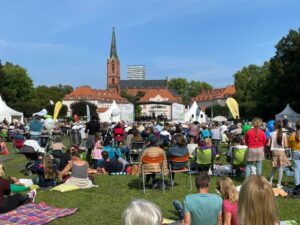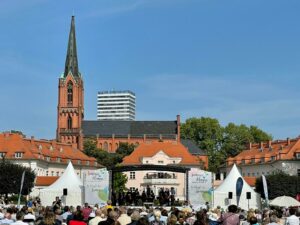In deep learning the layers are allowed to separate and deviate considerably from knowledgeable connecting models, to be economical, trained and comprehendible, wherever the "structured" half emerges.
What is Deep Learning ?
In deep learning (also referred to as in-depth structured reading) is an element of a wider family of machine learning ways supported artificial neural networks with representative learning.
Reading is monitored, partly monitored or supervised. The development of deep learning like deep neural networks, deep belief networks, deep strengthening learning, repetitive neural networks and convolutional neural networks employed in fields as well as PC vision, speech recognition, linguistic communication process, artificial intelligence, bioinform drug, medical image analysis, quality testing and parlor game programs, wherever they turn out comparable results and in some cases surpass the performance of human specialists.
Artificial neural networks (ANNs) square measure inspired by the process of data and unfold communication sites in biological systems. ANNs have a spread of variations from blood vessels. Specifically, neural artificial networks tend to face out and become symbolic, whereas the blood vessels of the many living things square measure robust (plastic) and analogue.
The term “deep” in deep learning refers to the utilization of multiple layers in an exceedingly network. Preliminary work has shown that the precise perceptron cannot separate the universe, however that a network with to perform of nonpolynomial activation with one hidden layer of infinite breadth will.
In deep learning could be a fashionable variation associated with the unlimited variety of layers of guaranteed size, that permits for economical use and implementation, whereas being unbroken all over underneath stripped-down conditions.
In deep learning the layers are allowed to separate and deviate considerably from knowledgeable connecting models, to be economical, trained and comprehendible, wherever the "structured" half emerges. Many fashionable varieties of deep learning square measure supported artificial neural networks, particularly convolutional neural networks (CNN) s, though they'll additionally incorporate paste-based formulas or smartly programmed showing intelligence into deep production models like nodes in deep belief systems and Boltzmann.
In deep learning, every level learns to show its input file into AN unambiguous and integrated illustration. Within the image recognition application, the inexperienced input is a component matrix; the primary illustration layer will extract pixels and write edges; the second layer will write and integrate the written material of the edges; the third layer will embody the nose and eyes; and therefore the fourth layer will see that the image contains a face.
Significantly, depth learning method will learn what components ought to be placed well at that level. This doesn't utterly scale back the requirement for hand repairs; for instance, totally different completely different layers of layers and layer sizes will offer different output levels.
The term "deep" in "deep learning" refers to the quantity of layers through that information is born-again. Specifically, in-deep learning systems have a comprehensive credit distribution system (CAP). CAP could be a series of changes from input to output.
CAPs describe the doable link between input and output. In an exceedingly feed forward neural network, the deep of the CAPs is that of the network and is that the variety of hidden layers and one (as the output layer is additionally a parameter).
In duplicate neural networks, wherever the signal is distributed by quite one layer, the deep of the CAP could also be unlimited. There's no united limit to the deep of the globe that separates deep learning from in-deep learning, however most researchers agree that deep learning involves CAP quite a pair of deep.
Apart from that, most layers don't add network capabilities. In deep models (CAP> 2) square measure ready to turn out higher options than shallow models and so, extra layers facilitate to review the options a lot of effectively. Deep learning structures is made in an exceedingly means that enriches every layer.
Deep study helps to differentiate these extracts and choose that options improve performance. In supervised learning activities, deep learning ways eliminate feature engineering, translating information into intermediate displays admire key elements, and discovering stone structures that take away demolition from illustration.
Deep learning algorithms is employed in unsupervised learning activities. This is often a vital advantage as a result of unregistered information is way a lot of saturated than labelled information. Samples of deep frames that may be willy-nilly trained square measure neural history compressors and deep belief networks.
History of Deep Learning
Other sources make it clear that Frank Rosenblatt designed and tested all the basic ingredients of today's deep learning programs. He described it in his book "Principles of Neurodynamics: Perceptrons and the theory of Brain Mechanisms", published by Cornell Aeronautical Laboratory, Inc., at Cornell University in 1962. The first standard-reading, comprehensive, deep , multi-variety learning algorithm was published by Alexey Ivakhnenko and Lapa in 1967.
The 1971 paper described an deep network of eight layers trained in group data management. Other deep learning structures, especially those designed for computer simulation, began with the Neocognitron introduced by Kunihiko Fukushima in 1980.
The term Deep Learning was introduced to the electronic learning community by Rina Dechter in 1986, and to neural networks implanted by Igor Aizenberg and colleagues in 2000, in the form of Boolean threshold neurons. In 1989, Yann LeCun etc.
AI used a standard back-to-back algorithm, which has been a way of reverting to auto splitting since the 1970s, into a deep neural network for the purpose of detecting handwritten ZIP codes. While the algorithm works, training requires 3 days.
In 1994, André de Carvalho, along with Mike Fairhurst and David Bisset, published the results of a multi-layered boolean neural network, also known as a lightweight, neural network module (SOFT). Followed by a multi-layer classification neural network module (GSN), which was independently trained. Each layer in the feature removal module has released features with increasing difficulty with respect to the previous layer.
In 1995, Brendan Frey demonstrated the possibility of training (more than two days) a network consisting of six fully integrated layers and a few hundred hidden units using a sleep-wake algorithm, developed in collaboration with Peter Dayan and Hinton.
Several factors contribute to the acceleration of speed, including the problem of gradient disappearance that was analyzed in 1991 by Sepp Hochreiter. Since 1997, Sven Behnke has expanded the Neural Abstraction Pyramid's propulsion system with back-to-back connections to easily incorporate context into conclusions and resolve spatial ambiguities.
Simple models using hand-crafted features such as Gabor filters and vector support machines (SVMs) were popular in the 1990s and 2000s, due to the artificial neural network (ANN) costs and the lack of understanding of how the cerebral cables work its biological networks. Both shallow and deep readings (e.g., repetitive nets) of ANNs have been tested for many years.
These methods have never succeeded in modeling a variety of handmade indoor / hidden Markov (GMM-HMM) technology based on discriminated production production models. Significant complications were analyzed, including gradient shrinkage and temporal weak structure in neural predictive models.
Adding difficulty was the lack of training data and limited computer power. Many speech recognition researchers have moved away from neural networks following artificial insemination. The exception was SRI International in the late 1990s.
Sponsored by the NSA and DARPA of the US government, SRI has studied deep neural networks in speech and speaker information. The speaker recognition team led by Larry Heck reported great success with deep neural networks in speech processing at the 1998 National Institute of Standards and Technology Speaker Recognition.
An deep SRI neural network was then used in Nuance Verifier, representing the first industrial system for deep learning. The goal of promoting "immature" features in addition to manual use was first tested successfully in the development of a deep auto encoder in the "green" spectrogram or features of a filter bank in the late 1990s, which shows its superiority in Mel-Cepstral features containing phases of constant change from spectrograms . The raw elements of speech, the forms of waves, later produced excellent results of scale.

